Informative speeches are often given on topics that the audience is unfamiliar with, whether it is in a professional, educational, or social setting. This speech is typically prepared following a basic outline to ensure the listeners receive valuable knowledge. Moreover, the outline helps the speaker deliver information effectively and increase audience engagement by structuring it in a logical and organized manner.
This article will introduce readers to such a speech and discuss the basic components of the outline for creating it. It also provides best practices for preparing this speech and examples you can use as a reference to better understand how to structure these.
What is an Informative Speech?
An informative speech is a means of conversing or public speaking where the speaker educates the audience on a particular topic they are not familiar with.
The speaker provides facts, insights, and examples to enlighten the audience. The goal is to educate, not persuade, and therefore, should be free of personal opinions or biases to allow the audience to create their own.
There are four major types:
- Explanatory
- Demonstrative
- Descriptive
- Definition speeches.
To enhance engagement and effectiveness, speakers can utilize visual aids such as slides, diagrams, or videos. Visual aids serve to support and reinforce the spoken content, making it easier for the audience to comprehend and remember the information. It can teach any topic, including scientific findings, social issues, technological innovations, cultural traditions, smoking habits, etc.
Basic Format of Speech Outline
You must organize the content rationally and present it in a manner that is easy to understand. This is achieved by using the correct outline, which is a framework for organizing and presenting information effectively during a speech or presentation.
The basic outline guides you on the points to include and the order in which they should be presented to avoid stress during the preparation stage. This enhances the logical flow of information when delivering the speech. Consequently, this increases the clarity and coherence of your topic.
Below are the fundamental components of such an outline:
Title
The first item on the outline is the title of the topic you will be discussing. The title is meant to introduce the topic by giving them an idea of what will be discussed. It should be short, descriptive, and captivating to grasp the audience’s interest.
EXAMPLE
“Origin of mental health in the NFL.”
General purpose
Each speech is given with an objective or objectives in mind. The general purpose states the overall objective of the speech, which is typically to educate, inform the audience or raise awareness about a particular topic.
EXAMPLE
“The long-term negative consequences of contact sports in the country.”
Specific purpose
The specific purpose narrows down to what you intend to achieve through it. You should indicate what the audience should expect to learn by the end of the speech.
EXAMPLE
“To educate the audience on how concussions affect the health of players in the NFL.”
Thesis statement
A complete outline will include a thesis statement which is an overview of the main message to be delivered. This statement is meant to guide you on the main idea you want to convey to the audience.
EXAMPLE
“Constant knocks to the head of a player leads to concussions and the lack of policies to compel players to enroll into mental health programs after retiring lowers chances of timely interventions.”
Introduction
The introduction is used to provide a preview of the key points to be discussed in it. It should capture the audience’s attention and provide enough details to generate their curiosity.
The introduction will have the following components:
Attention getter
This is an element used to capture the audience’s attention before you delve into the topic. It can be a quote, question, statistic, poem, or anecdote. The element should be relevant to the topic, engaging, and thought-provoking. However, the quote does not have to be related to the topic. Only use one element at a time.
EXAMPLE
“Do you know that 3 out of 10 ex-NFL players struggle with mental health issues.”
Topic & audience relevance
Start by explaining why and how the topic is relevant to the audience. To craft a valuable explanation, talk about the significance of the topic to the individuals, specific groups, and society at large. Also, relate the topic to the audience’s interests, experiences, industry, and concerns.
You can discuss and highlight how your speech will benefit or impact the audience. Also, identify common ground with the audience, which can be a shared experience or values to establish a connection that can elicit empathy or understanding.
Establish credibility
Your credibility can impact how well the audience receives your speech. So, your outline should help you prepare how to establish credibility.
Credibility can be established by stating the following:
- Qualifications – This includes relevant education achievements, professional experience, and certifications.
- Expertise – Specify your profession and any relevant projects or research you have undertaken in a related field.
- Personal experience – Share any real-life experiences you have had that would qualify you to discuss the topic in question.
- Research – If you have conducted any research on a particular topic, inform the audience. Also, you can reference people you have consulted in regard to the topic. If they are credible sources, this increases the credibility of your speech.
Preview of main points
The outline prompts you to preview the main points of the topic to be discussed in brief phrases and sentences. This will help the audience understand and anticipate the format in which information will be delivered and the content of your speech. Present the headings logically to help the audience follow along more easily.
Body
The body component in the outline discusses the main content or topic and supporting information. It is meant to prompt you to write down all the main points to be discussed. The content will have the main points, which are then broken down into subpoints. You should consider discussing 3-5 main points, but these can vary depending on the length of your speech.
This section will have the following parts:
Transition sentence to the main point
This is a sentence made to end the introduction and start the body seamlessly. This transition sentence helps the audience follow your speech and maintain a logical flow of information. You should add transition sentences and phrases whenever you want to connect different but related points.
Main point
The main point is the core idea, concept, or fact you want to convey to the audience. It should support the thesis and can be given in a single sentence. Also, avoid any ambiguity, as every other piece of information is meant to further expound on this point.
Subpoints
Sub-points are arguments meant to elaborate on the main point. These may include explanations, examples, or research findings. Sub-points will focus on specific aspects, facts, and principles that help clarify the main point. You can have multiple sub-points depending on the depth of information you want to provide.
Sub-sub points
Sub-sub points are used to justify or break down subpoints. These include statistics, examples, stories, and references that provide additional information and reinforce the main point. They should aim at improving the audience’s understanding. Then, for each main point, provide subpoints and sub-subpoints to maintain the logical flow of the speech.
Conclusion
This component of the outline is meant to guide you to end the speech on a positive note. It summarizes the information shared with the audience.
Reiterate the key point(s) by incorporating the following elements in your conclusion:
Transition sentence to conclusion
The transition sentence from the last main point to the conclusion indicates to the audience that you are about to finalize your speech. Use transition words, phrases, and sentences to connect everything discussed in the entire speech.
Summary of main points
Briefly summarize the key message you wanted to educate the audience about. Also, state any key takeaways the audience should keep in their mind.
Restate your thesis
Restate the thesis in the introduction using different words but retaining the argument. Also, connect the message to your purpose. Reiteration of key elements etches the main idea or concept in the audience’s minds.
Closing statement
At the end, provide a closing argument that is memorable and impactful. Aim to leave a lasting and positive impression on the audience in one of the following ways:
- Call to action – A call to action directs the audience to take specific actions related to the topic discussed in the speech. For instance, participate in a program, change their behavior, support a cause, etc.
- Thought-provoking question – You can end by raising a question that jogs the audience’s mind and prompts them to learn more about a topic.
- Powerful quote – Use a quote that is relevant to the message to strengthen the main points further and leave the audience thinking.
- Hopeful message – Also, you can end with an inspiring message to motivate and inspire the audience in different aspects of their lives, such as being kind, working for their goals, patience, etc. Ending on a positive note can encourage the audience to retain the information you conveyed.
When you follow this simple outline during the preparation stage, your key message will be delivered effectively, and the sitting will prove productive for you and the audience. However, note that you can modify this basic format to ensure your speech aligns with the time constraints and the topic in question.
Free Templates
Given below are outline templates that you can download for free:
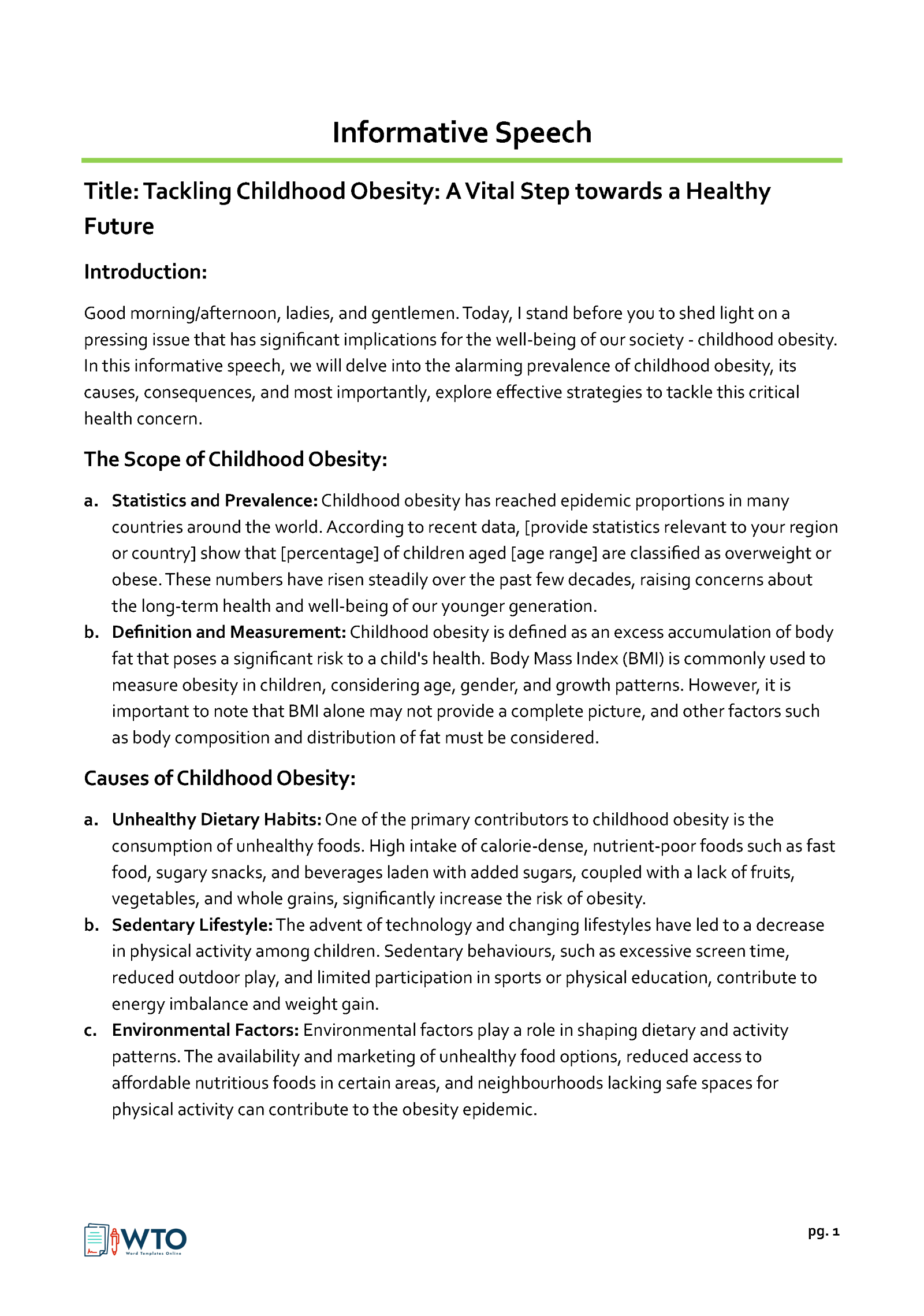
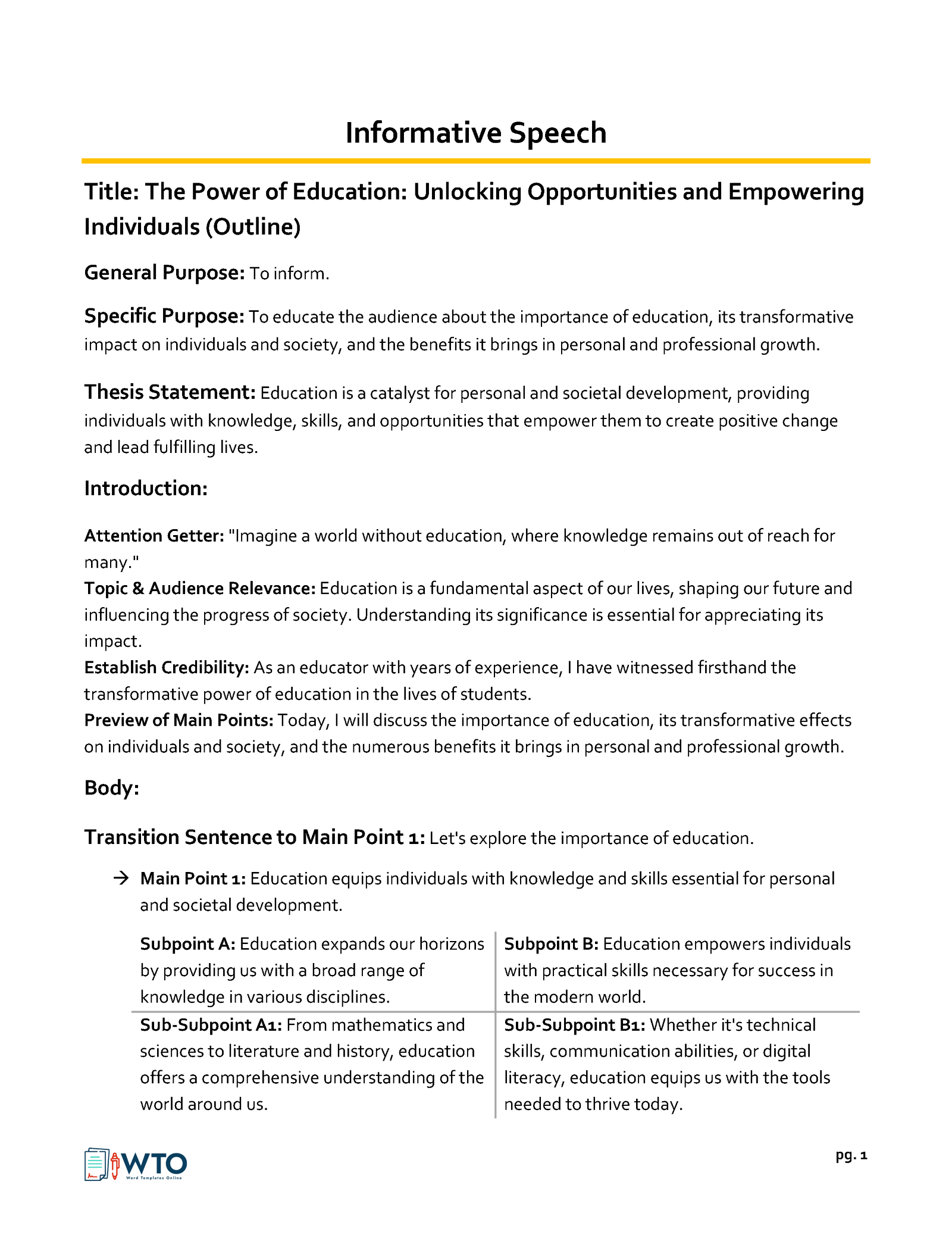
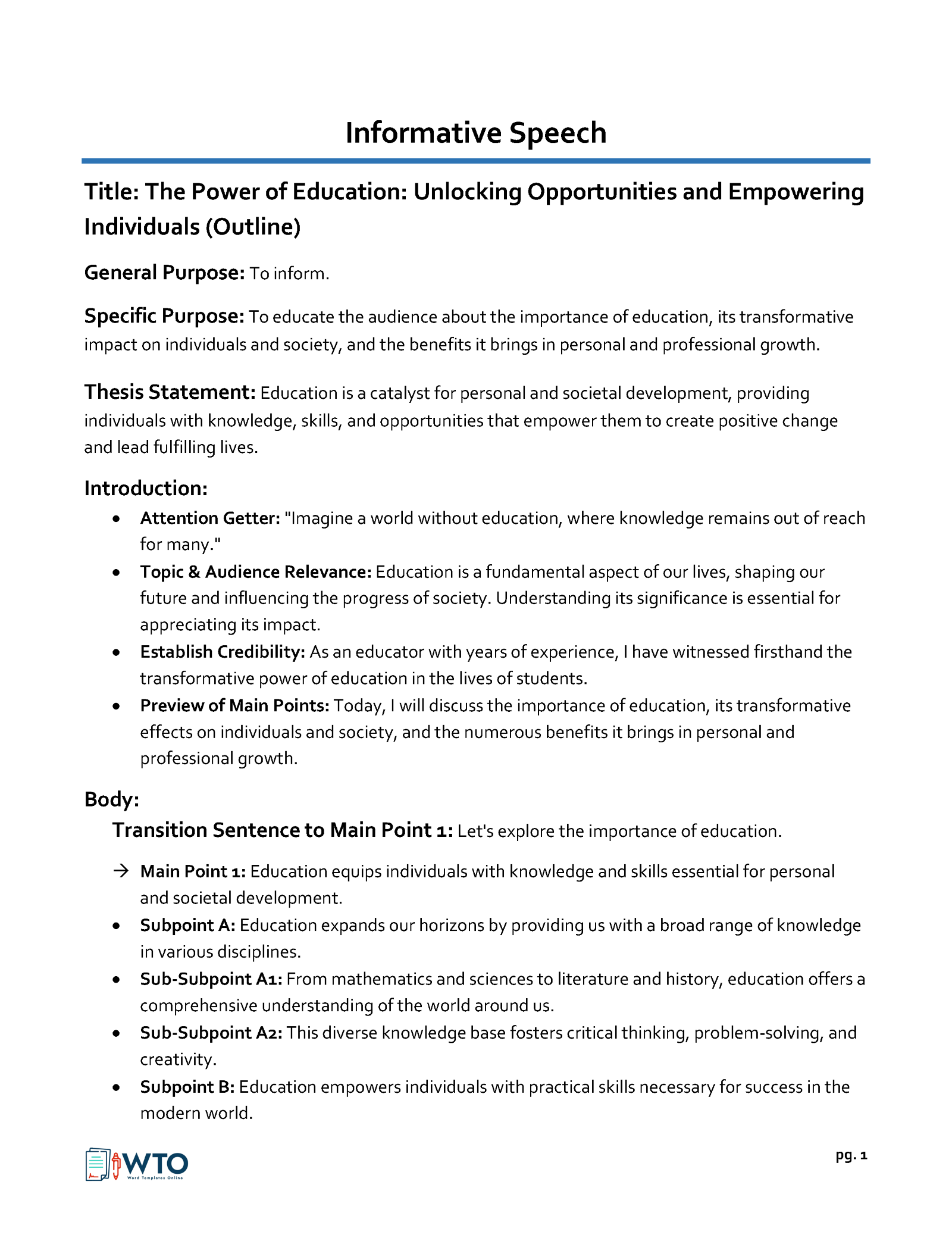

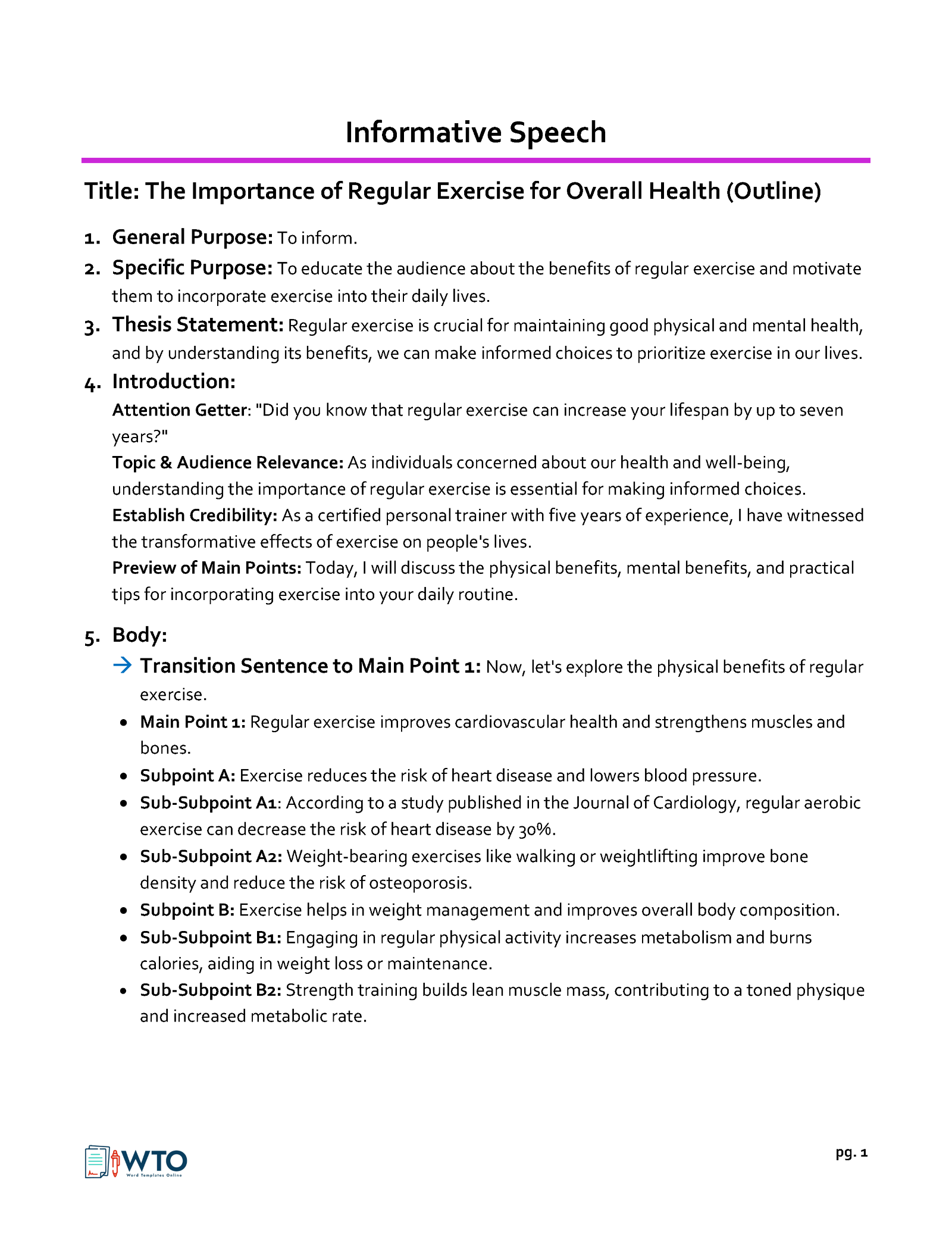

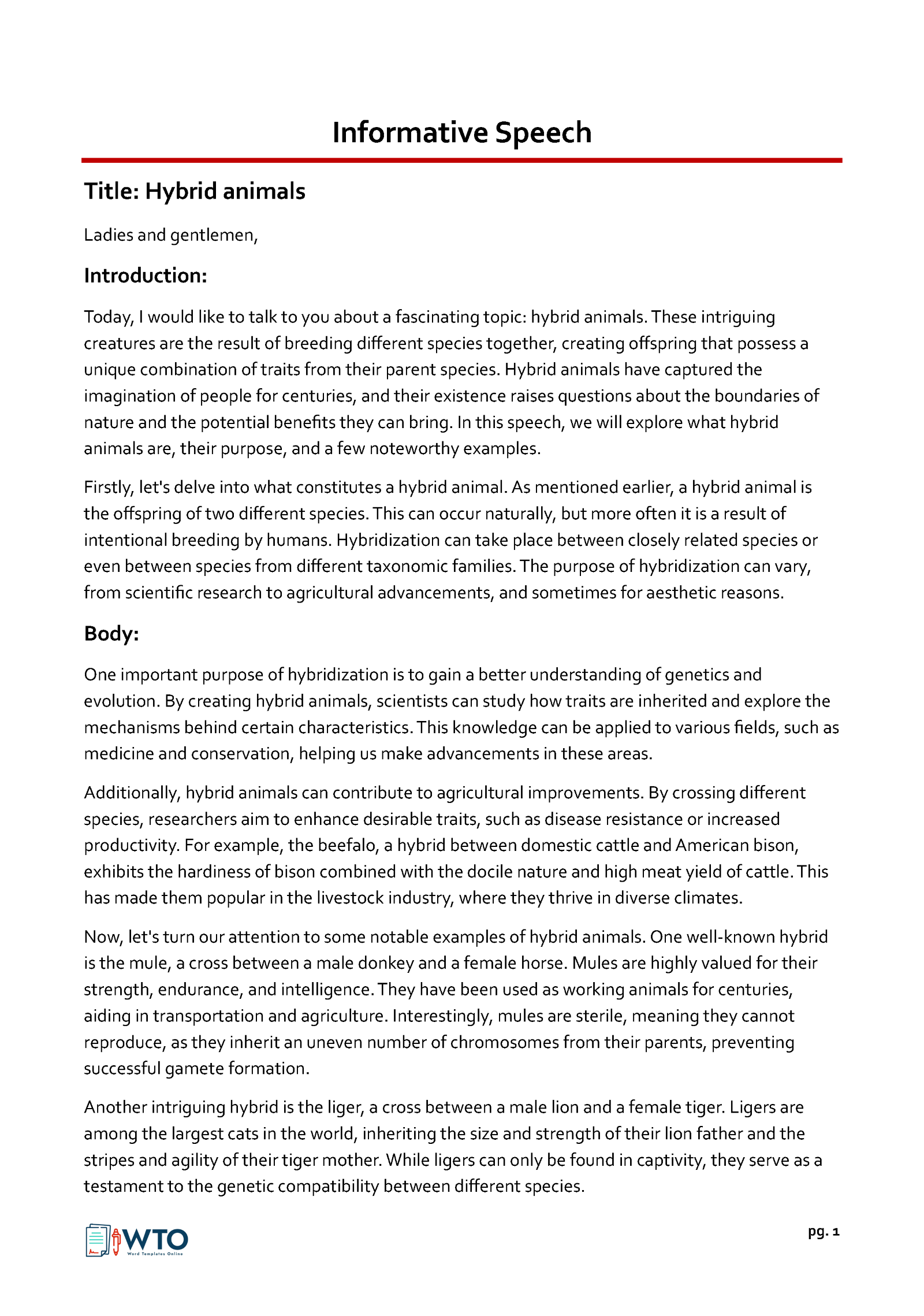
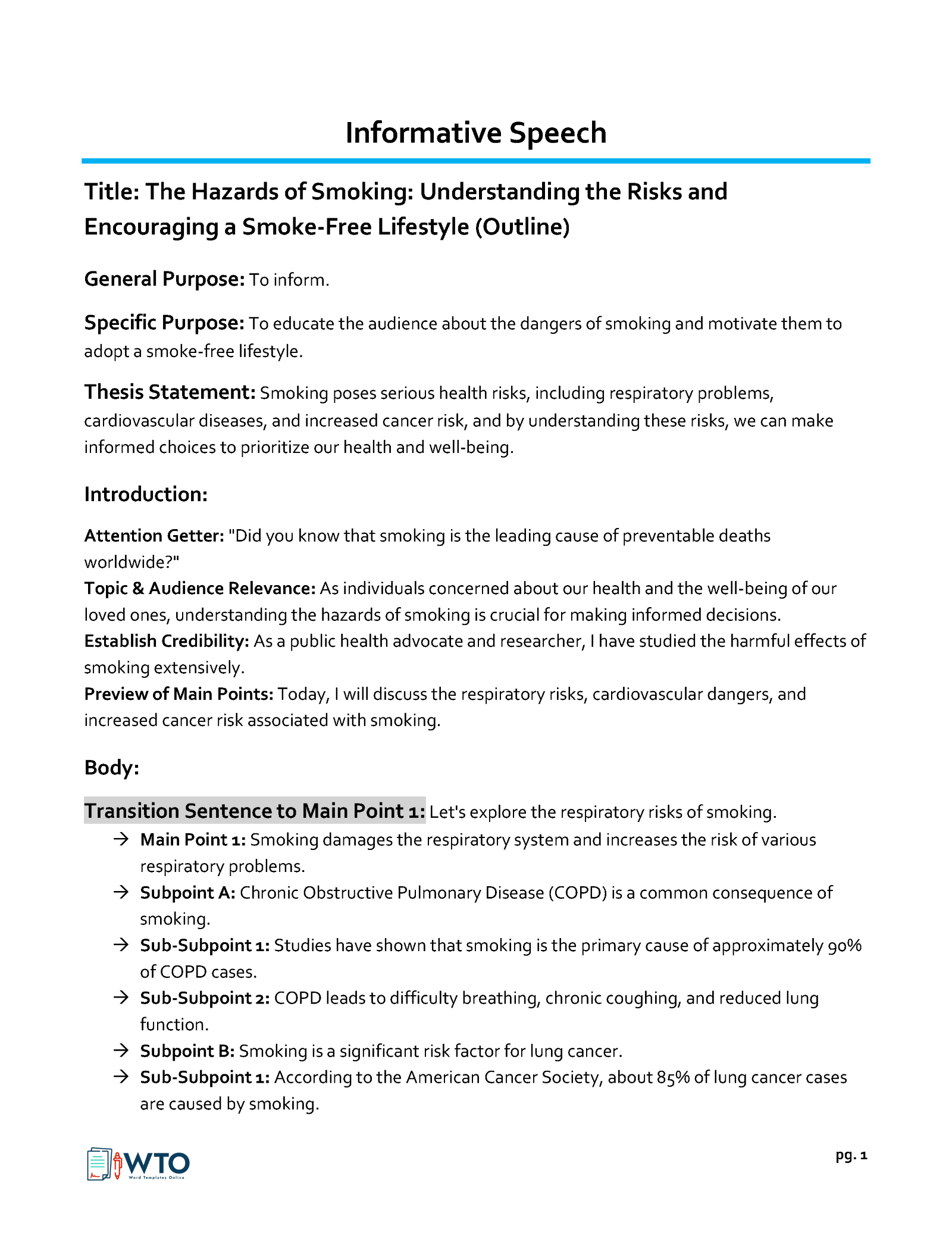
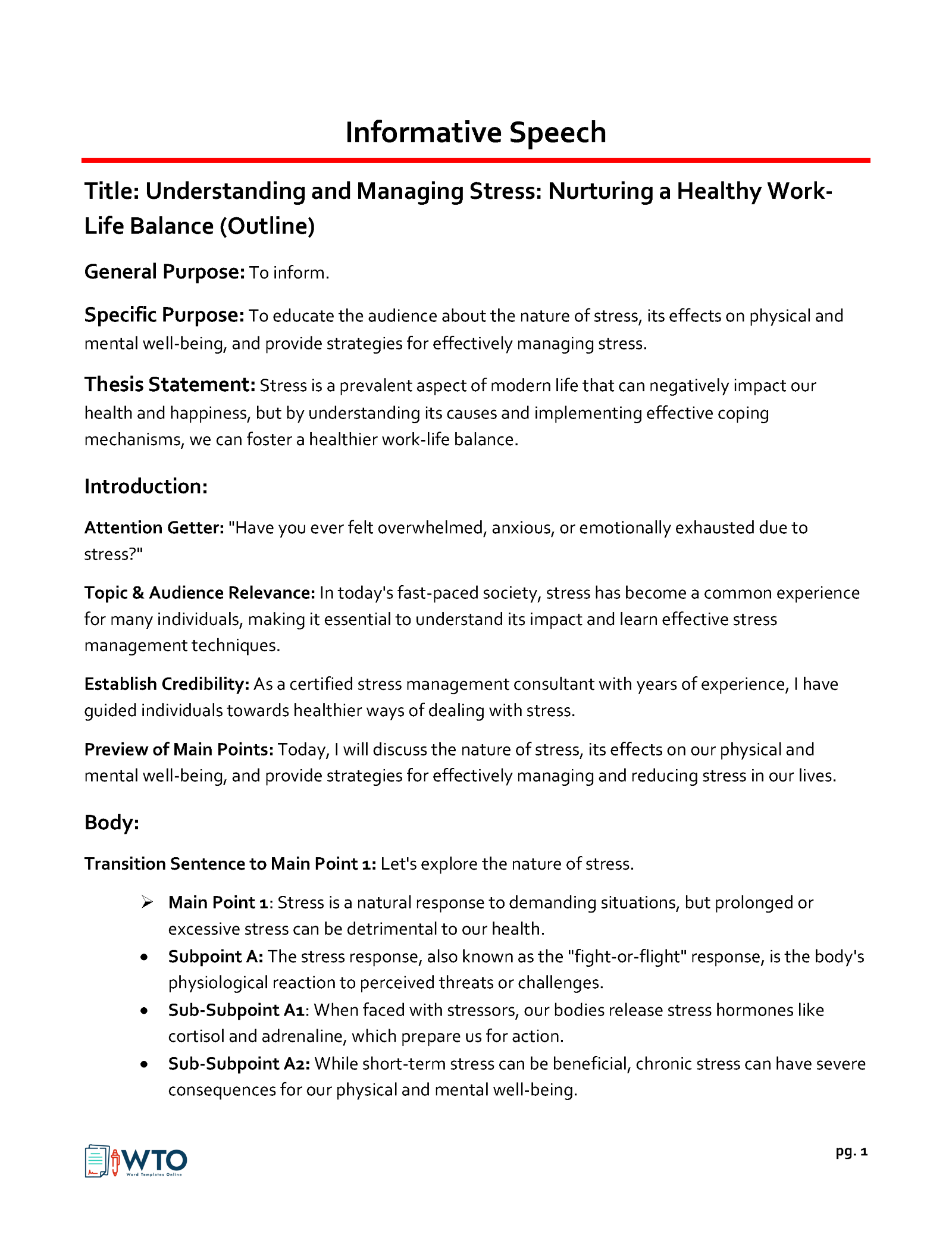
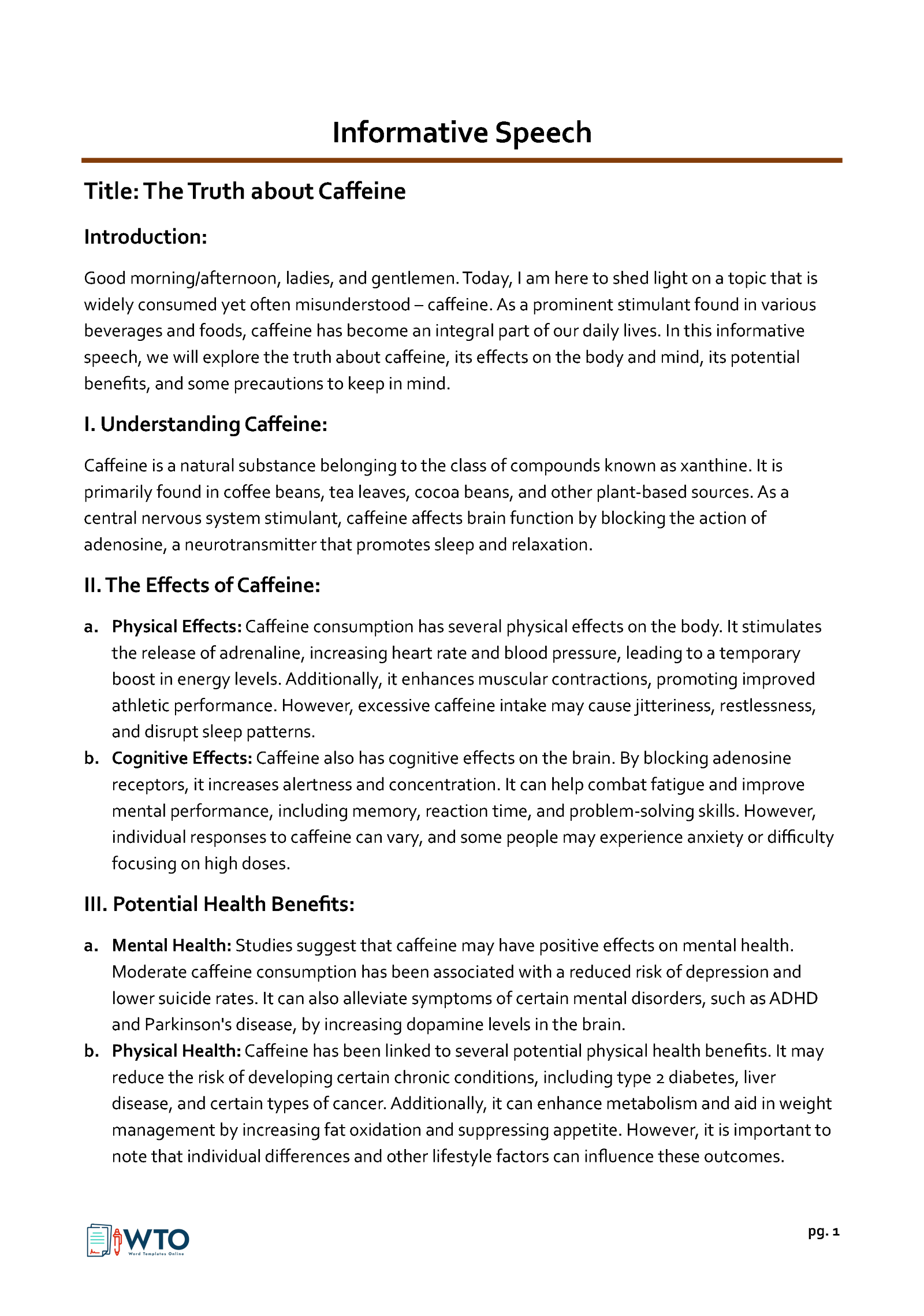
4 Best Practices to Consider for Writing an Outline
Your outline should help you capture all the relevant details and organize them in a comprehensive and palatable message. So you can tailor it to the specific speech you are preparing.
Below are things you can do to develop a more effective outline:
Research thoroughly
Research your topic extensively and gather accurate, reliable, and up-to-date information. Then, you can craft an outline that captures and conveys this information effectively.
Consult examples
Review multiple examples to get an idea of the basic format of well-structured speeches. Identify how to introduce a topic, convey the key message and conclude the speech. Then, craft your outline and incorporate any unique elements and strategies that will be effective depending on the topic, audience, and forum.
Use visual aids
You can use charts, images, slides, and props to explain your points. Visual aids increase audience engagement and understanding. They can also be useful to explain complex concepts and leave lasting impressions.
Engage the audience
Encourage the audience to actively participate during the sitting by asking questions, holding polls, or doing short activities that break the monotony and keep their minds engaged. This can make it more memorable and help the audience understand the key message better.
Conclusion
Informative speeches are effective tools for educating an audience on a topic you are well-versed with. However, to ensure you convey your message effectively, it is advisable to use a simple outline to prepare how to speak to the audience. While there are basic outline templates you can download, you should personalize them to suit your topic and style of giving speeches. Also, it is advisable to consult several samples to understand how to organize your points.




